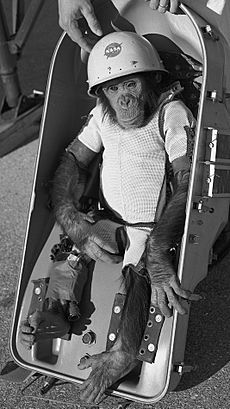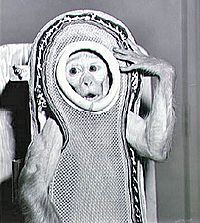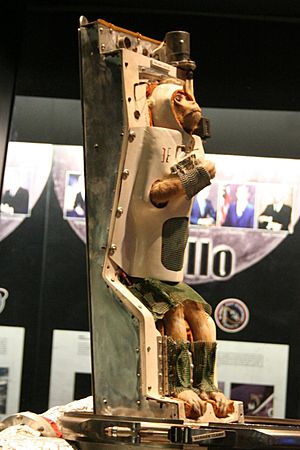Monkeys and apes in space facts for kids

Before humans traveled to space in the 1960s, many animals were sent into space. This included different types of primates like monkeys and chimpanzees. Scientists wanted to study the effects of space travel on living things. The United States launched flights with primates mostly between 1948 and 1961, with a few later flights in 1969 and 1985. France sent two monkeys into space in 1967. The Soviet Union and Russia also launched monkeys from 1983 to 1996. Most of these primates were given medicine to make them sleep before their rockets took off.
In total, 32 non-human primates flew into space, and none of them flew more than once. Many other primates were trained but never actually went to space. The monkeys and apes used were from several species, including rhesus macaques, crab-eating macaques, squirrel monkeys, pig-tailed macaques, and chimpanzees.
Contents
Pioneering Primate Space Missions in the United States


The first primate to go very high into the atmosphere was Albert, a rhesus macaque. On June 11, 1948, he rode a V-2 rocket to over 63 km (39 mi). Sadly, Albert did not survive the flight.
On June 14, 1949, Albert II became the first monkey, primate, and mammal to reach space. He flew past the Kármán line (100 km), which is considered the start of space, reaching 134 km (83 mi). However, he did not survive the landing because his parachute failed.
Later, on September 16, 1949, Albert III was on a V2 rocket that exploded. On December 8, Albert IV, the second mammal in space, also did not survive his landing after another parachute problem. Alberts I, II, and IV were rhesus macaques, while Albert III was a crab-eating macaque.
Monkeys on Aerobee Rockets
Monkeys later flew on Aerobee rockets. On April 18, 1951, a monkey, possibly named Albert V, did not survive due to a parachute failure. Yorick, also known as Albert VI, flew with 11 mice on September 20, 1951. He reached 236,000 ft (72 km) and survived the landing, becoming the first monkey to do so. However, he passed away two hours later. Two of the mice also died. These deaths were thought to be from stress due to overheating in the sealed capsule while waiting for the rescue team.
Patricia and Mike, two cynomolgus monkeys, flew on May 21, 1952, and survived. Their flight only went up to 26 kilometers.
Gordo's Journey
On December 13, 1958, Gordo, a squirrel monkey, was launched by the US Army aboard Jupiter AM-13. He flew over 1,500 miles and reached a height of 310 miles (500 km) before returning to Earth. Gordo landed in the South Atlantic but did not survive because his parachute recovery system failed.
Able and Miss Baker's Historic Flight
On May 28, 1959, Able, a rhesus macaque, and Miss Baker, a squirrel monkey from Peru, had a successful mission aboard the JUPITER AM-18. They traveled faster than 16,000 km/h and experienced strong forces. Able passed away on June 1, 1959, during surgery to remove an infected medical wire, due to a reaction to the medicine. Miss Baker became the first monkey to survive the challenges of spaceflight and the medical procedures. She lived until November 29, 1984, at the age of 27. She is buried at the United States Space & Rocket Center in Huntsville, Alabama. Able was preserved and is now on display at the Smithsonian Institution's National Air and Space Museum. Their names came from the US military phonetic alphabet.
Monkeys in the Mercury Program
On December 4, 1959, Sam, a rhesus macaque, flew on the Little Joe 2 rocket in the Mercury program to 53 miles high. On January 21, 1960, Miss Sam, also a rhesus macaque, flew on Little Joe 1B to test emergency procedures, though her flight was only to 8 mi (13 km).
Chimpanzees Ham and Enos also flew in the Mercury program. Ham was the first great ape to go into space. The names "Sam" and "Ham" were short for the places where they were trained. Ham and Enos were among 60 chimpanzees brought to New Mexico by the U.S. Air Force for space flight tests.
Goliath, a squirrel monkey, did not survive when his Atlas rocket exploded on November 10, 1961. A rhesus macaque named Scatback flew on December 20, 1961, but was lost at sea after landing.
Later US Primate Missions
Bonny, a pig-tailed macaque, flew on Biosatellite 3 from June 29 to July 8, 1969. This was the first multi-day monkey flight, but it happened after humans were already making longer spaceflights. Bonny passed away within a day of landing.
On the Space Shuttle flight STS-51-B (called Spacelab 3), two squirrel monkeys, No. 3165 and No. 384-80, flew from April 29 to May 6, 1985.
France's Monkey Missions
France launched a pig-tailed macaque named Martine on a Vesta rocket on March 7, 1967. Another monkey, Pierette, flew on March 13. These flights went up to 243 km (151 mi) and 234 km (145 mi). Martine became the first monkey to survive for more than a few hours after flying above the international edge of space. (Ham and Enos, launched by the United States earlier, were chimpanzees, not monkeys).
Soviet Union and Russia's Bion Program
The Soviet and Russian space programs used only rhesus macaques in their Bion satellite program in the 1980s and 1990s. The monkeys' names started with letters from the Russian alphabet. All the animals survived their missions, except for one who passed away during surgery after returning. After this, the program was stopped.
- The first monkeys launched by the Soviet program, Abrek and Bion, flew on Bion 6 from December 14 to December 20, 1983.
- Next were Verny and Gordy on Bion 7 from July 10 to July 17, 1985.
- Then Dryoma and Yerosha on Bion 8 from September 29 to October 12, 1987. After returning, Dryoma was given as a gift to Cuban leader Fidel Castro.
- Bion 9 carried Zhakonya and Zabiyaka from September 15 to September 28, 1989. They set a record for monkeys, staying in space for 13 days and 17 hours.
- Monkeys Ivasha and Krosh flew on Bion 10 from December 29, 1992, to January 7, 1993. Krosh later had babies after returning to Earth.
- Lapik and Multik were the last monkeys in space for a while. They flew aboard Bion 11 from December 24, 1996, to January 7, 1997. Multik passed away during a medical procedure after returning. Lapik also had a difficult time with the same procedure.
Argentina's Space Monkey
On December 23, 1969, Argentina launched Juan, a tufted capuchin monkey, using a Rigel 04 rocket. He went up to about 82 kilometers and was recovered safely. This was below the international definition of space (100 km). Later, on February 1, 1970, a female monkey of the same type was launched. She went higher but was lost after her capsule's parachute failed.
China's Secret Space Monkey
The PRC spacecraft Shenzhou 2 launched on January 9, 2001. It is believed that a monkey, a dog, and a rabbit were inside to test the spacecraft's life support systems. The spacecraft landed on January 16. No pictures of the recovered capsule were shown, leading some to think the flight had problems. Reports suggested a parachute issue caused a hard landing.
Iran's Monkey Launches
On January 28, 2013, news agencies reported that Iran had sent a monkey in a "Pishgam" rocket to a height of 72 miles (116 km) and safely brought it back. There was some confusion because old photos were published, but astronomers confirmed a successful launch in 2013.
On December 14, 2013, Iran again sent a monkey to space and safely returned it. Rhesus macaques Aftab (on January 28, 2013) and Fargam (on December 14, 2013) were each launched separately and returned safely. Researchers are still studying the effects of these space trips on their babies.
See also
 In Spanish: Monos en el espacio para niños
In Spanish: Monos en el espacio para niños
- Laika
- Soviet space dogs
- Ham (chimpanzee)
- Human spaceflight
- Animals in space
- Space exploration
- Alice King Chatham (a sculptor who designed oxygen masks and safety gear for animals in the U.S. space program)
- Captain Simian & the Space Monkeys (a 1996 television series)
- Space Chimps (a 2008 film)


